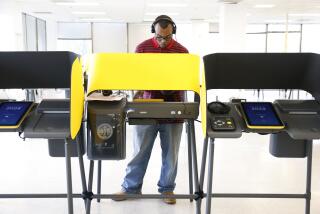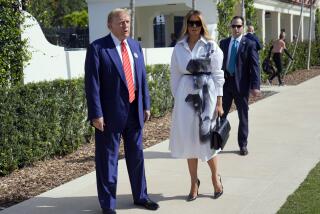Why Biden still leads and why that might not last
A week after the first Democratic primary debates, Joe Biden still leads the field but as a diminished front-runner, a raft of post-debate polls show.
The first round of debates reshaped the race: Instead of a single front-runner, there’s now a well defined first tier of candidates, all within striking distance of each other — Biden and Sens. Kamala Harris, Elizabeth Warren and Bernie Sanders.
Between now and the next debates at the end of the month, two big questions hang over the field: Can Biden learn from a bad showing, and can any of the candidates in the struggling second tier break through?
Sign up for the Essential Politics newsletter »
WHAT THE POLLS SHOW
At least six major national polls and one in Iowa have surveyed Democratic primary voters since the debates. They all have somewhat different pictures of the race, and it’s best to look at the averages.
Taken together, here are three things they show:
Voters still think Biden has the best shot at beating President Trump, and that’s buoying his candidacy.
Biden’s strength on that measure has slipped, but it hasn’t disappeared. In the Washington Post/ABC News poll, for example, 45% of Democrats and Democratic-leaning independents said Biden had the best chance of winning, with Sanders way back at 18%, Harris at 9% and Warren at 7%.
That strength flows from a mix of factors: support for Biden, familiarity and, as our USC Dornsife/Los Angeles Times poll showed before the debate, a belief by many Democrats that a politically experienced, white, male candidate offers them their best shot at victory.
But that source of strength for Biden also creates a risk: If he has a series of poor debate performances, voters may decide he’s not so electable after all. Like puncturing a balloon, bursting the belief in his electability could cause a lot of damage to his candidacy.
Among the top candidates, Biden is alone in pitching his appeal to moderate voters.
Liberals outnumber moderates in some Democratic primaries, although not all. But right now, Warren, Sanders and Harris divide the liberal vote, while Biden dominates among moderate Democrats.
In the Quinnipiac University poll, for example, Biden had support from 30% of self-described moderates. That’s almost as much as the other three combined.
Biden emphasized that ideological divide in speeches and interviews over the past week. In an interview aired Friday morning on CNN, for example, he said he was “happy to debate that issue.”
“Look who won last time out,” he said, referring to the midterm elections for Congress last year: “Mainstream Democrats who are very progressive on social issues and very strong on education and healthcare.”
The Democratic party, he said, is “center left, that’s where I am. Where it’s not is way left.”
Some second-tier candidates, notably South Bend, Ind., Mayor Pete Buttigieg and Sen. Amy Klobuchar of Minnesota, have pitched a similar, moderate approach. A big question for the next phase of the campaign will be whether either of them, or anyone else, can break through to seriously challenge Biden’s lead among moderates.
A lot of those moderate voters are black, and they continue to be a key base of support for the former vice president.
The most ideologically committed liberals among Democrats tend to be white college graduates. African American voters, especially older ones, more often describe themselves as moderate.
Harris’ sharp attack on Biden for the close working relationship he had early in his career with segregationist senators, especially on the issue of school busing, could dislodge some of his black support.
On the substance of that issue, Michael Finnegan, Seema Mehta and Melanie Mason had this look at school busing in Berkeley during Harris’ childhood.
On the politics, some polls have shown Harris eating into Biden’s support among black voters. Achieving that goal is key for her hope of winning.
But eight years as President Obama’s No. 2 provides a powerful seal of approval for him.
DESPERATION ON THE LOWER DECK
There’s a do or die struggle right now among the second-tier candidates to survive until the third debate, in September.
For the June and July debates, candidates needed to have 1% support in polls or 65,000 individual donors. For the September debate, those numbers double and the “or” becomes an “and.”
At first glance, 2% support in polls doesn’t sound like a high hurdle. But take the support for the top four candidates — all of whom will meet the requirements — and add in those who say they have no preference. The total adds up to 80%-85% in polls right now. That doesn’t leave much for the other 20 candidates to divvy up.
For the September debate, polls taken from June 28 through Aug. 28 are all that count, so candidates are, in effect, starting over. But here’s where things stand now.
Buttigieg leads the second tier, in part because of his enormous success in raising money — $24.8 million in the second quarter, which was more than anyone else in the field, as Tina Daunt wrote. He has consistently polled well above the 2% threshold, so his campaign seems in good shape to keep going.
Among the rest, Sen. Cory Booker of New Jersey and former Rep. Beto O’Rourke of Texas have typically topped 2% in recent polls. Klobuchar and Julián Castro, the former Housing secretary, have done so in some polls, as has Andrew Yang, the tech entrepreneur.
Among that group, O’Rourke and Yang have said they have hit the 130,000 donor threshold for September. The other three still have a ways to go.
No other candidates have hit 2% in recent polls.
So by September, there’s a good chance the Democratic field will be down to 10 candidates, perhaps fewer.
With a much smaller field, candidates now in the second tier might have an easier time gaining attention. But those who don’t make the debate stage will have a tough time continuing.
FLIP-FLOP ON CENSUS
For well over a year, the Trump administration has pushed an effort to add a question to next year’s census asking people if they’re citizens.
Democrats — and many neutral experts — said the question would surely discourage many immigrants, regardless of their status, from responding to the census. That could cause a serious undercount, which would cost immigrant-heavy states like California billions of dollars in federal funds and, perhaps, a congressional seat or two.
That could bolster Republican political power, which is exactly what a lot of Democrats suspect the question was designed to do.
Last week, the Supreme Court blocked the question in a 5-4 decision, saying that Commerce Secretary Wilbur Ross had failed to present an honest justification for adding the question. But the opinion by Chief Justice John G. Roberts Jr. said the administration could try again to present a legally acceptable rationale.
That’s where matters stood as of Tuesday, when the administration abruptly gave up the fight, as David Savage and Noah Bierman wrote.
Ross announced that the Census Bureau, which Commerce oversees, would begin printing the 2020 census forms without the question, and Justice Department lawyers notified courts of the decision.
The next day, Trump reversed course again, tweeting that he had instructed Commerce and Justice to find a way to keep the question.
Whether the president changed his mind under pressure from conservatives, who have lobbied hard for a fight on the issue, or whether he never agreed with the decision to proceed in the first place is unknown.
The transcript of a court hearing Wednesday shows a flummoxed Justice Department lawyer explaining to a federal district judge that he had no idea that a change of position was coming until he saw Trump’s tweet.
What comes next? Government lawyers could provide an indication of their next step as early as this afternoon.
Ultimately, though, the issue likely will boil down to whether the administration can convince Roberts, who holds the swing vote on the high court, that they’ve come up with a valid reason to proceed.
POLITICIZING THE WHITE HOUSE
Trump has gone further than any of his modern predecessors toward breaking down the boundaries between official, taxpayer-funded duties and campaign politics, Bierman wrote.
One of the clearest examples is the administration’s open defiance of the Hatch Act, the federal law that is supposed to keep government employees away from partisan activity. Trump has refused to enforce the act against his advisor, Kellyanne Conway, despite recommendations by his own appointee who heads the office that administers the law that she be fired for repeated violations.
Critics also pointed to Trump’s Fourth of July extravaganza as an example of inserting politics into a formerly nonpartisan national celebration. As Caroline Engelmayer wrote, Trump ended up sticking to a nonpartisan speech, but even his presence on the national Mall was enough to generate protests and controversy.
A LESS MONIED CONGRESS
The freshman House class brings less wealth to Congress than their predecessors, Jennifer Haberkorn reported.
More than 30% of the class has a net worth of under $100,000, and the median is $412,011 — nearly $100,000 less than the average for Congress last year. That could bring a new perspective to debates, some members say.
LOGISTICS
That wraps up this week. Until next time, keep track of all the developments in national politics and the Trump administration at our Politics page and on Twitter @latimespolitics.
Send your comments, suggestions and news tips to politics@latimes.com.
If you like this newsletter, tell your friends to sign up.
More to Read
Get the L.A. Times Politics newsletter
Deeply reported insights into legislation, politics and policy from Sacramento, Washington and beyond. In your inbox three times per week.
You may occasionally receive promotional content from the Los Angeles Times.







